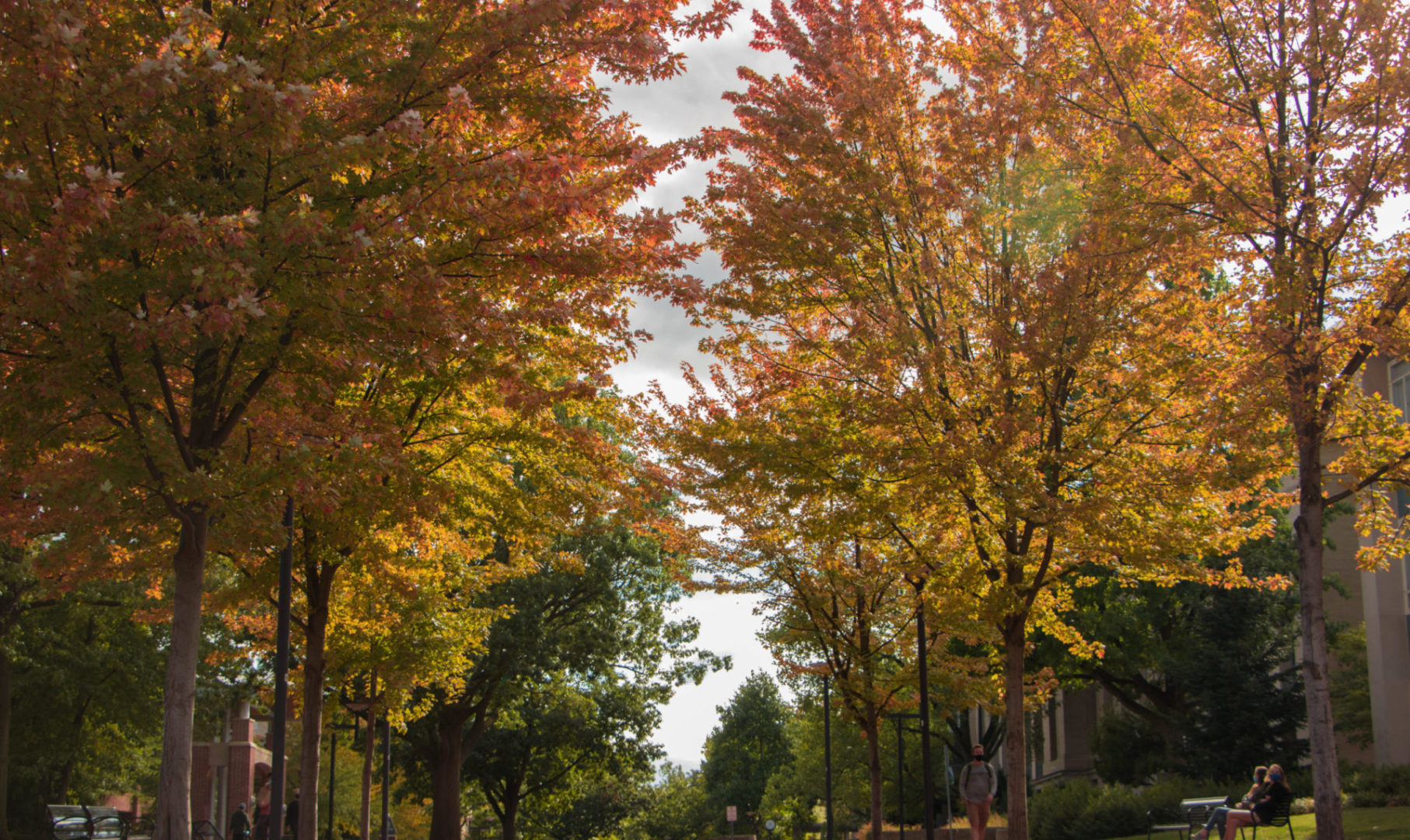
With fall weather's swift arrival, leaves will soon be changing colors, as seen here on the Penn State campus in October 2020. Photo by Mira DiBattiste | Onward State

With fall weather's swift arrival, leaves will soon be changing colors, as seen here on the Penn State campus in October 2020. Photo by Mira DiBattiste | Onward State
Such equinoctial exactitude.
Autumn showed the airlines, our national railroad and lollygagging students how it’s done last Thursday, showing up right on time.
That Sept. 22 morning, it was still summer. The rain was a summer rain. Then, whoosh, fall blew in on the wind, like Mary Poppins.
Immediately, the ballet began: weakly attached leaves slaloming through the air, each describing its own arc, as individual as snowflakes. Jacketless, I felt a delicious chill.
This isn’t usual. Winter, in particular, is a great encroacher on the other seasons, arriving while it’s still fall, then lingering into spring.
Summer is less predictable, but it, too, likes to get here early and leave late. So it is that our comfiest seasons, weather-wise, are the shortest, alas.
The arrival of fall brings joy and dread. Joy because some fall days are perfect: warm sun, cool breeze, flaming trees, puffy clouds, dazzling clarity early, golden light late and then cool air coming in the bedroom window at night. Dread because we begin to feel winter’s icy fingers on the backs of our necks.
When my daughter Sylvie was a preschooler, she watched a barber apply hot lather to my bewhiskered cheeks and chin, then shave my face clean with a straight razor (an experience I highly recommend). When the hot towel came off my glistening mug, she eyeballed the stranger before her and issued this order: “Put it back.”
That’s what I want to say when the leaves come down. I love their turning and their twirling, but then I want to rewind the tape.
Some of you, I’m sure, like winter’s gray-and-brown palette, the coziness of wool sweaters and steamy kitchens and fire in the hearth, the clean look and scent of fresh snow. I like it, too, for about a month.
What I like best, though, is cool, not cold or warm or hot; and bright color, not muted color. (I like the neon green of early spring just as much as I like the purple-red-orange-yellow dazzle coming our way in the next few weeks.) When it comes to air temperature, I’m a 60s man, forced, too often, to live in an 80s and 40s world.
Last week’s abrupt transition from summer to fall got me thinking about how different the seasons are from each other, and how little I knew about why.
I knew that the word equinox contains the idea of nights (and therefore days) of roughly equal length. And I knew that the Earth’s orbit around the sun is elliptical rather than circular, which means there are times when our collective finger is moving toward the flame and times when we’re drawing back from it.
Naturally I assumed that winter is when we’re farthest from the sun and summer is when we’re closest. But this is why a little bit of knowledge is a dangerous thing.
It turns out that the Earth is closest to the sun (perihelion) in early January and farthest from it (aphelion) in early July. Don’t you love counterintuitive stuff like that?
The difference between our perihelion and aphelion distance from the sun is about 4 million miles, which sounds like a lot – I drove 7,000 miles during the summer and that felt like a lot – but is actually negligible when you’re talking about two heavenly bodies that are (on average) 93 million miles apart.
Putting it another way, the change in distance from the sun has little to do with why we snow ski in winter and water ski in summer (and when I say we, I don’t mean me. I never snow skied enough to get good at it and I never waterskied at all, which I regret.)
That leaves the planet’s 23.5-degree tilt: We Northern Hemisphereans lean away from the sun in winter and toward it in summer. I knew that, too. But I was always surprised by what a dramatic difference the tilt makes, just as I’m surprised at how much cooler the air feels when a cloud comes between me and the sun, and how cold I can be on a brilliantly sunny day in January.
So for a fuller explanation I turned to the only astronomer I know who comes from the island of Cyprus, Mike Eracleous, a professor at Penn State. Eracleous went with the flashlight analogy, which goes like this:
If you point a flashlight directly at a wall, you get a nice, tight circle of light. If you angle the flashlight, the illuminated area gets bigger, but the illumination is weaker. The same amount of energy is hitting the wall, but there’s less of it at any one point because it’s more spread out.
That tight circle of light is what we get in summer, when we’re tilted toward the sun. The more diffuse beam is what we get in winter, when we’re tilted away from the sun.
Got that? Good. Now we can replace the batteries in our flashlights and get the warm clothes out of the attic.
Receive all the latest news and events right to your inbox.

80% of consumers turn to directories with reviews to find a local business.